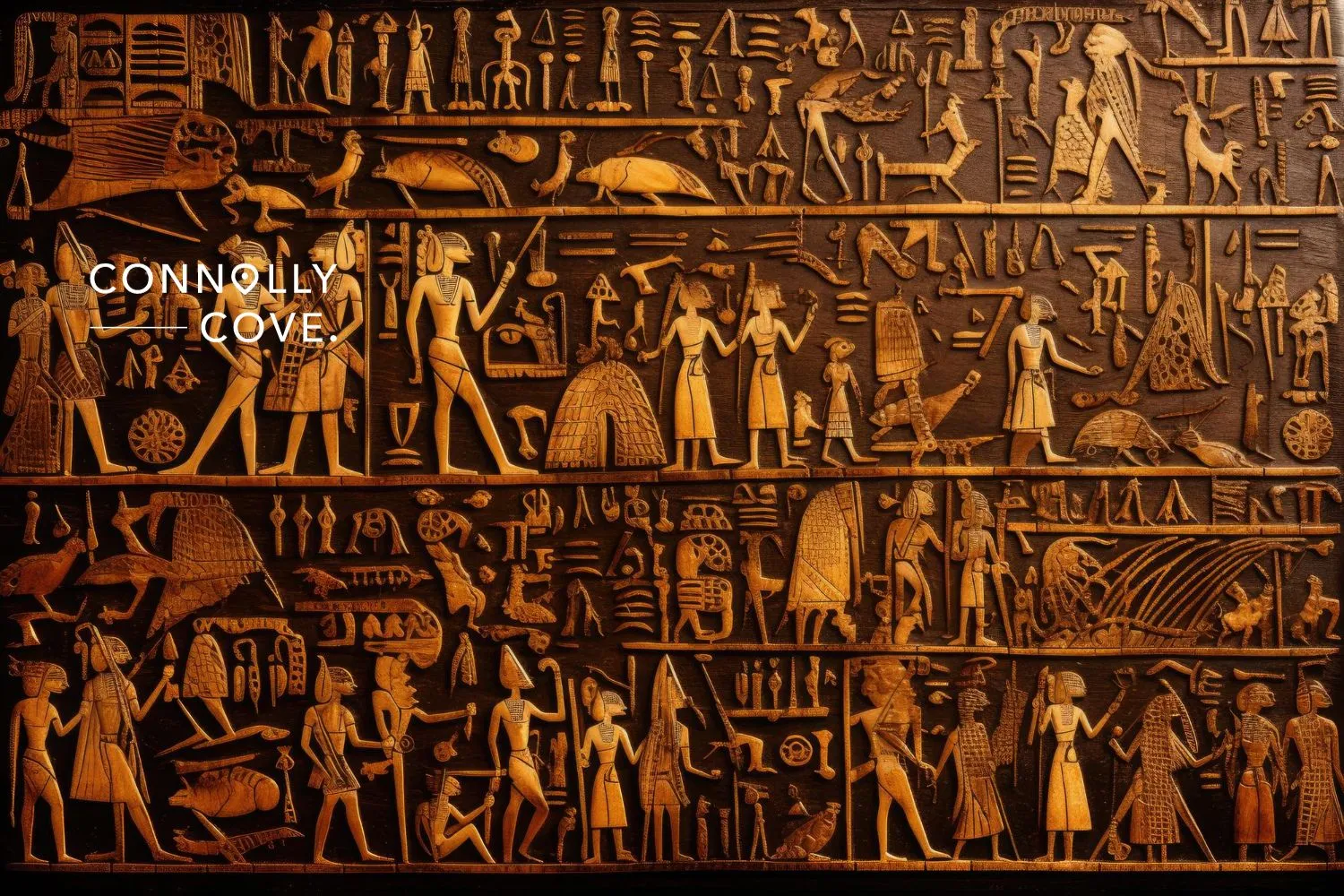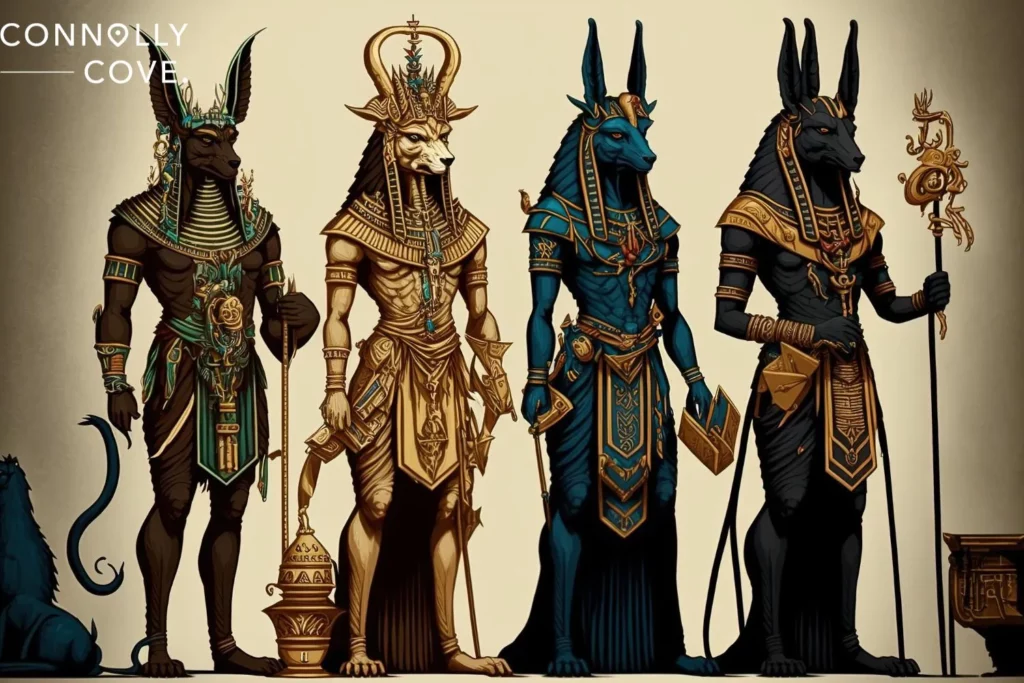Hedjwer: The Ancient Egyptian Baboon Deity and Solar God

Updated On: February 19, 2024 by Yasmin Elwan
Embarking on a journey through the enigmatic world of ancient Egyptian mythology, it’s easy to find oneself both baffled and intrigued by the myriad deities with their animal representations. If you are curious enough to peel back layers of cultural narratives, you’ve likely stumbled across Hedjwer, an entrancing Solar God brought to life as baboons in symbolic form.
This article seeks to gently unpick the complex weave of beliefs around Hedjwer, highlighting his importance within ancient artistry, spirituality and lunar folklore. Shall we set off on this exploration through time together?
Origins and Significance of the Deity
Hedjwer, an ancient Egyptian deity, holds great significance as both a solar god and baboon in the Late Predynastic Period. People back then looked at Hedjwer in two ways—as a scary force and a wise guide. Baboons, tied to him, were seen as smart and strong like the morning sun. This link came from their real-life actions where they raise their arms to the rising sun, just like saying hi to divine power. Big statues of baboons stood tall at temple doors in ancient times.
This shows how much Egyptians loved these animals and saw them as gods on earth living a good life near religious places. Also known by another name, Babi, Hedjwer was linked with the underworld and raw power that male baboons embody, which was held high by ancient Egyptian culture. He also has ties with Ra, who stands for travel across the sky from west to east daily.
Symbolism as a Solar God and Baboon
Although Hedjwer is a lesser-known deity in the extensive pantheon of ancient Egyptian mythology, he holds a unique place as a symbol of solar power and is often depicted as a baboon. In Egyptian symbolism, the baboon is closely associated with the sun, primarily due to its habit of greeting the sunrise with loud calls, giving the impression of worshipping the first light of day. This behaviour led the ancient Egyptians to connect baboons with the sun god Ra, viewing them as sacred animals that hailed the sun’s daily rebirth.
Hedjwer, in this context, embodied the aspects of solar energy and its cyclical nature of renewal and rejuvenation. As a solar deity, he was seen as a guardian of both the sun itself and the powerful life-giving force it represented. The baboon form of Hedjwer further signified intelligence, aggression, and virility, attributes that were highly regarded in the animal kingdom and respected by the Egyptians.
Moreover, baboons were also associated with Thoth, the god of wisdom, linking Hedjwer to the realms of knowledge and the divine. This dual symbolism of Hedjwer as a solar god and a baboon highlights the complexity of Egyptian religion, where animals were not just venerated for their physical attributes but also for their perceived connection to the celestial and spiritual worlds.
Representation in Art and Architecture
Colossal statues of baboons were a common sight at the entrance of temples in ancient Egypt. These impressive sculptures captured the raw power and untamed energy associated with Hedjwer, the baboon deity and solar god.
Baboons were often shown with their arms raised in worship of the sun, symbolising their connection to Divine Consciousness. In ancient Egyptian belief, animals incarnated by gods or goddesses lived near religious centres and were treated with great reverence.
The representation of Hedjwer in art and architecture serves as a reminder of the wisdom and ferocity embodied by these fascinating creatures.
The Etymology of the Name “Hedjwer” and Its Significance
The name Hedjwer (also spelled Hekawer) is derived from the ancient Egyptian words “hedj” meaning “black” or “dark” and “wer” meaning “great” or “powerful”. Thus, the name Hedjwer can be interpreted as “the black one” or “the dark one”. This etymology reflects Hedjwer’s association with the Black Land, the fertile region of Egypt along the Nile River. The dark, rich soil of the Black Land was essential for Egypt’s agricultural prosperity, and Hedjwer was seen as a protector and benefactor of this vital region.
Hedjwer was also sometimes shown with the goddess Hathor, who was associated with fertility and motherhood. This connection further highlights the deity’s role as a life-bringer and protector of the Black Land.
The Worship Practices and Rituals Associated With Hedjwer
Our understanding of the worship practices and rituals associated with Hedjwer, the ancient Egyptian deity, is somewhat limited due to the relatively obscure status of this god in the Egyptian pantheon. Unlike major gods such as Osiris, Ra, or Isis, whose worship was widespread and well-documented, Hedjwer did not have a prominent cult or significant temples dedicated to his worship.
However, based on what is known about ancient Egyptian religious practices, it is likely that any veneration of the baboon deity would have followed typical forms of Egyptian ritual. This might have included offerings, prayers, and possibly small shrines. Given Hedjwer’s association with the West and the afterlife, any rituals might have had a funerary aspect, possibly invoking his protection or guidance for the souls of the deceased as they journeyed to the afterlife.
The use of baboon imagery, due to Hedjwer’s representation as a baboon, might have played a role in these practices. Baboons were considered sacred to several Egyptian deities and were often associated with the sun god Ra and the god of wisdom, Thoth. They were known to be revered, and their images were used in various religious and funerary contexts, which could suggest a similar reverence in rituals connected to that ancient Egyptian god.
Other Egyptian Deities

The pantheon of ancient Egyptian deities is a complex and fascinating tapestry woven with gods and goddesses who played pivotal roles in the daily lives and afterlives of the ancient Egyptians. Among these, deities like Ra and Thoth stand as towering figures, each embodying crucial aspects of existence and cosmic order.
These deities, with their distinct and rich mythologies, were not just revered as mighty beings but also deeply ingrained in the cultural and spiritual fabric of ancient Egypt. Their tales, symbolism, and influence shed light on the values, beliefs, and understanding of the universe that shaped one of history’s most remarkable civilisations. As we explore these ancient Egyptian deities further, we step into a world where mythology and reality intertwine, offering a glimpse into the ancient Egyptians’ quest for understanding and meaning.
Ra, the Sun God of Ancient Egypt
Ra, the ancient Egyptian sun god, stands as one of the most significant and revered deities in Egyptian mythology. Symbolising the sun and its life-giving power, Ra was considered the king of the gods and the creator of all. Each day, he was believed to travel across the sky in his solar boat, bringing light and warmth to the earth, a journey that represented the cycle of birth, life, and rebirth.
At night, he traversed the underworld, defeating the forces of chaos and ensuring the continuity of the cosmic order. Ra was often depicted as a man with the head of a falcon, crowned with a sun disc encircled by a sacred cobra. This iconography underscored his role as a powerful and protective figure. Over time, Ra’s identity merged with other gods, most notably with Amun, forming Amun-Ra, a representation of the supreme power of the universe.
Worship of Ra was widespread, with the city of Heliopolis serving as a major centre of his cult. Temples dedicated to Ra often featured obelisks and sun temples designed to capture the symbolism of his journey and power. The reverence for Ra permeated every aspect of ancient Egyptian culture, from royal titles to architectural designs, reflecting his status as the epitome of divine authority and the life force.
Thoth, the God of the Moon and Master of Knowledge
In the captivating mythology of ancient Egypt, Thoth stands as a deity of immense wisdom and knowledge. Revered as the God of the Moon and the Master of Knowledge, Thoth was often depicted with the head of an ibis or as a baboon, animals considered symbols of wisdom. He played a crucial role as the inventor of hieroglyphic writing, the mediator of disputes among gods, and the recorder of events in the divine realm.
Thoth was also the guardian of knowledge, sciences, and the arts, and he was believed to be the scribe of the underworld, maintaining the universe’s balance by recording the deeds of the deceased. His association with the moon stemmed from his role as the measurer of time and the regulator of the lunar calendar, which was key to the ancient Egyptians’ agricultural and ritual activities.
Temples dedicated to Thoth, such as those at Khmun (Hermopolis), became centres of learning and wisdom, reflecting his status as the patron of scribes and scholars. His influence was so profound that the Greeks identified him with Hermes, giving rise to the syncretic deity Hermes Trismegistus and influencing the Hermetic traditions. Thoth’s legacy as a symbol of intellect and knowledge endures, embodying the ancient Egyptians’ deep reverence for wisdom and the pursuit of understanding.
Hedjwer offers a unique glimpse into the complex religious and cultural fabric of ancient Egypt. As a symbol of the West and the afterlife, Hedjwer’s representation and significance highlight the Egyptians’ intricate beliefs surrounding death and the journey of the soul. Exploring figures like Hedjwer not only enriches our understanding of ancient Egyptian spirituality but also reminds us of the countless narratives and symbols that have shaped human civilisation’s quest for meaning across time and cultures.






